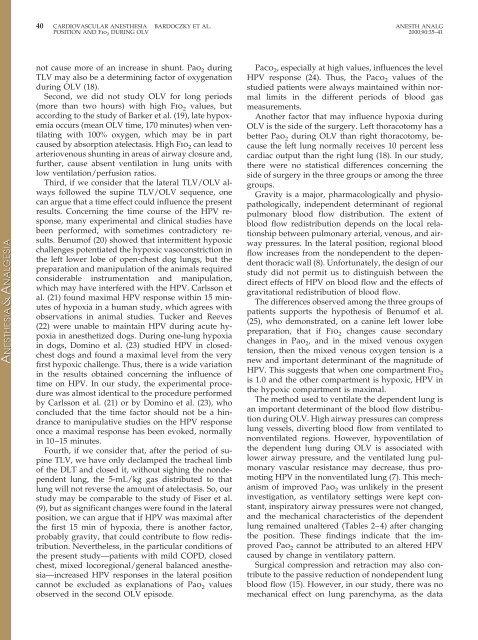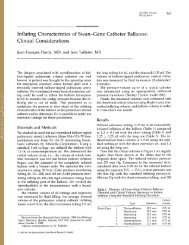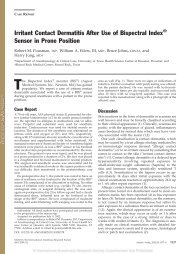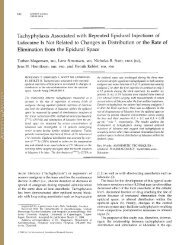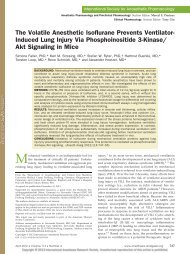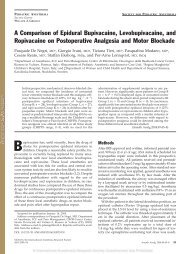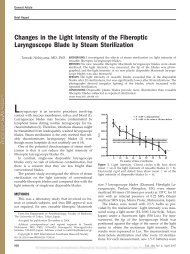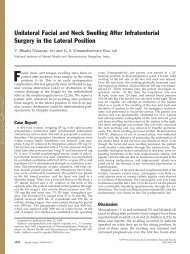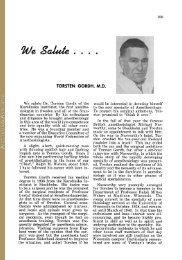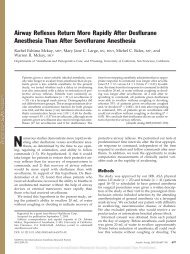Two-Lung and One-Lung Ventilation in Patients - Anesthesia ...
Two-Lung and One-Lung Ventilation in Patients - Anesthesia ...
Two-Lung and One-Lung Ventilation in Patients - Anesthesia ...
You also want an ePaper? Increase the reach of your titles
YUMPU automatically turns print PDFs into web optimized ePapers that Google loves.
40 CARDIOVASCULAR ANESTHESIA BARDOCZKY ET AL. ANESTH ANALG<br />
POSITION AND Fio 2 DURING OLV 2000;90:35–41<br />
not cause more of an <strong>in</strong>crease <strong>in</strong> shunt. Pao 2 dur<strong>in</strong>g<br />
TLV may also be a determ<strong>in</strong><strong>in</strong>g factor of oxygenation<br />
dur<strong>in</strong>g OLV (18).<br />
Second, we did not study OLV for long periods<br />
(more than two hours) with high Fio 2 values, but<br />
accord<strong>in</strong>g to the study of Barker et al. (19), late hypoxemia<br />
occurs (mean OLV time, 170 m<strong>in</strong>utes) when ventilat<strong>in</strong>g<br />
with 100% oxygen, which may be <strong>in</strong> part<br />
caused by absorption atelectasis. High Fio 2 can lead to<br />
arteriovenous shunt<strong>in</strong>g <strong>in</strong> areas of airway closure <strong>and</strong>,<br />
further, cause absent ventilation <strong>in</strong> lung units with<br />
low ventilation/perfusion ratios.<br />
Third, if we consider that the lateral TLV/OLV always<br />
followed the sup<strong>in</strong>e TLV/OLV sequence, one<br />
can argue that a time effect could <strong>in</strong>fluence the present<br />
results. Concern<strong>in</strong>g the time course of the HPV response,<br />
many experimental <strong>and</strong> cl<strong>in</strong>ical studies have<br />
been performed, with sometimes contradictory results.<br />
Benumof (20) showed that <strong>in</strong>termittent hypoxic<br />
challenges potentiated the hypoxic vasoconstriction <strong>in</strong><br />
the left lower lobe of open-chest dog lungs, but the<br />
preparation <strong>and</strong> manipulation of the animals required<br />
considerable <strong>in</strong>strumentation <strong>and</strong> manipulation,<br />
which may have <strong>in</strong>terfered with the HPV. Carlsson et<br />
al. (21) found maximal HPV response with<strong>in</strong> 15 m<strong>in</strong>utes<br />
of hypoxia <strong>in</strong> a human study, which agrees with<br />
observations <strong>in</strong> animal studies. Tucker <strong>and</strong> Reeves<br />
(22) were unable to ma<strong>in</strong>ta<strong>in</strong> HPV dur<strong>in</strong>g acute hypoxia<br />
<strong>in</strong> anesthetized dogs. Dur<strong>in</strong>g one-lung hypoxia<br />
<strong>in</strong> dogs, Dom<strong>in</strong>o et al. (23) studied HPV <strong>in</strong> closedchest<br />
dogs <strong>and</strong> found a maximal level from the very<br />
first hypoxic challenge. Thus, there is a wide variation<br />
<strong>in</strong> the results obta<strong>in</strong>ed concern<strong>in</strong>g the <strong>in</strong>fluence of<br />
time on HPV. In our study, the experimental procedure<br />
was almost identical to the procedure performed<br />
by Carlsson et al. (21) or by Dom<strong>in</strong>o et al. (23), who<br />
concluded that the time factor should not be a h<strong>in</strong>drance<br />
to manipulative studies on the HPV response<br />
once a maximal response has been evoked, normally<br />
<strong>in</strong> 10–15 m<strong>in</strong>utes.<br />
Fourth, if we consider that, after the period of sup<strong>in</strong>e<br />
TLV, we have only declamped the tracheal limb<br />
of the DLT <strong>and</strong> closed it, without sigh<strong>in</strong>g the nondependent<br />
lung, the 5-mL/kg gas distributed to that<br />
lung will not reverse the amount of atelectasis. So, our<br />
study may be comparable to the study of Fiser et al.<br />
(9), but as significant changes were found <strong>in</strong> the lateral<br />
position, we can argue that if HPV was maximal after<br />
the first 15 m<strong>in</strong> of hypoxia, there is another factor,<br />
probably gravity, that could contribute to flow redistribution.<br />
Nevertheless, <strong>in</strong> the particular conditions of<br />
the present study—patients with mild COPD, closed<br />
chest, mixed locoregional/general balanced anesthesia—<strong>in</strong>creased<br />
HPV responses <strong>in</strong> the lateral position<br />
cannot be excluded as explanations of Pao 2 values<br />
observed <strong>in</strong> the second OLV episode.<br />
Paco 2, especially at high values, <strong>in</strong>fluences the level<br />
HPV response (24). Thus, the Paco 2 values of the<br />
studied patients were always ma<strong>in</strong>ta<strong>in</strong>ed with<strong>in</strong> normal<br />
limits <strong>in</strong> the different periods of blood gas<br />
measurements.<br />
Another factor that may <strong>in</strong>fluence hypoxia dur<strong>in</strong>g<br />
OLV is the side of the surgery. Left thoracotomy has a<br />
better Pao 2 dur<strong>in</strong>g OLV than right thoracotomy, because<br />
the left lung normally receives 10 percent less<br />
cardiac output than the right lung (18). In our study,<br />
there were no statistical differences concern<strong>in</strong>g the<br />
side of surgery <strong>in</strong> the three groups or among the three<br />
groups.<br />
Gravity is a major, pharmacologically <strong>and</strong> physiopathologically,<br />
<strong>in</strong>dependent determ<strong>in</strong>ant of regional<br />
pulmonary blood flow distribution. The extent of<br />
blood flow redistribution depends on the local relationship<br />
between pulmonary arterial, venous, <strong>and</strong> airway<br />
pressures. In the lateral position, regional blood<br />
flow <strong>in</strong>creases from the nondependent to the dependent<br />
thoracic wall (8). Unfortunately, the design of our<br />
study did not permit us to dist<strong>in</strong>guish between the<br />
direct effects of HPV on blood flow <strong>and</strong> the effects of<br />
gravitational redistribution of blood flow.<br />
The differences observed among the three groups of<br />
patients supports the hypothesis of Benumof et al.<br />
(25), who demonstrated, on a can<strong>in</strong>e left lower lobe<br />
preparation, that if Fio 2 changes cause secondary<br />
changes <strong>in</strong> Pao 2, <strong>and</strong> <strong>in</strong> the mixed venous oxygen<br />
tension, then the mixed venous oxygen tension is a<br />
new <strong>and</strong> important determ<strong>in</strong>ant of the magnitude of<br />
HPV. This suggests that when one compartment Fio 2<br />
is 1.0 <strong>and</strong> the other compartment is hypoxic, HPV <strong>in</strong><br />
the hypoxic compartment is maximal.<br />
The method used to ventilate the dependent lung is<br />
an important determ<strong>in</strong>ant of the blood flow distribution<br />
dur<strong>in</strong>g OLV. High airway pressures can compress<br />
lung vessels, divert<strong>in</strong>g blood flow from ventilated to<br />
nonventilated regions. However, hypoventilation of<br />
the dependent lung dur<strong>in</strong>g OLV is associated with<br />
lower airway pressure, <strong>and</strong> the ventilated lung pulmonary<br />
vascular resistance may decrease, thus promot<strong>in</strong>g<br />
HPV <strong>in</strong> the nonventilated lung (7). This mechanism<br />
of improved Pao 2 was unlikely <strong>in</strong> the present<br />
<strong>in</strong>vestigation, as ventilatory sett<strong>in</strong>gs were kept constant,<br />
<strong>in</strong>spiratory airway pressures were not changed,<br />
<strong>and</strong> the mechanical characteristics of the dependent<br />
lung rema<strong>in</strong>ed unaltered (Tables 2–4) after chang<strong>in</strong>g<br />
the position. These f<strong>in</strong>d<strong>in</strong>gs <strong>in</strong>dicate that the improved<br />
Pao 2 cannot be attributed to an altered HPV<br />
caused by change <strong>in</strong> ventilatory pattern.<br />
Surgical compression <strong>and</strong> retraction may also contribute<br />
to the passive reduction of nondependent lung<br />
blood flow (15). However, <strong>in</strong> our study, there was no<br />
mechanical effect on lung parenchyma, as the data


